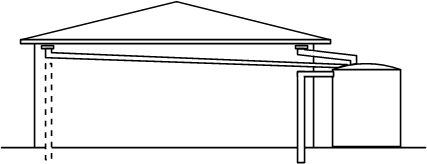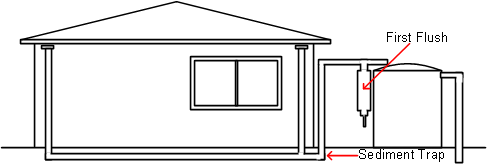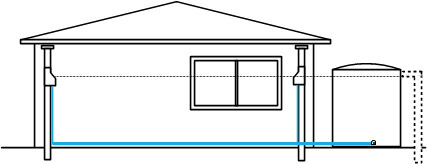Conventional plumbing diverted rainwater by 2 methods
(1) Diverting downpipes horizontally to the tank’s top inlet.
This is called a DRY SYSTEM as the pipes drain when it stops raining.

obtrusive pipework
expensive to install
expensive to install
Tanks are located close to the downpipe to avoid having downpipes diverted along walls or creating ugly pipe archways.
90mm PVC stormwater pipe usually replaces the downpipe.
The position of windows and doors often makes it impossible to harvest additional downpipes unless a WET SYSTEM is plumbed.
Unfiltered downpipes divert debris and pollutants to the tank’s top inlet and much of this will wash through the inlet mesh. This adds to the sediment layer and provides nutrients to thriving bacteria colonies.
Mosquitoes often gain access through inlet mesh screens that are damaged when owners run their hands over the mesh to remove larger debris. Another cause is when owners puncture clogged and difficult to clean overflow mesh to stop tanks overflowing. After just four months (May 2011) into a two year survey of 10,000 rainwater tanks across Brisbane, a Queensland Institute of Medical Research study found that up to 5% of Brisbane’s 100,000 tanks could be mosquito breeding grounds.
http://www.couriermail.com.au/ipad/tanks-for-that-dengue-fears-spiral/story-fn6ck45n-1226024702874
http://www.couriermail.com.au/ipad/tanks-for-that-dengue-fears-spiral/story-fn6ck45n-1226024702874
2) Plumbing a downpipe along or under the ground then vertically up a riser to the tank’s top inlet.
This is called a WET SYSTEM as the downpipes and pipes remain full of water to the level at the top of the riser unless drained. Wet systems have many problems.

expensive to install
ineffective capturing first flush
ineffective capturing first flush
The pipework’s low velocity will not transfer most debris up the vertical riser. Unless regularly flushed, sludge builds up inside the pipes and this can lead to stagnation and blockages.
Fitting a first flush kit at the top of a vertical riser is futile unless the wet system pipes are drained after every rain event. If not, the water that drains into the first flush will be the settled water in the riser while the first flush will still be in the downpipe!
Flushing wet systems wastes water, is messy and rarely effective due to the limited available dynamic head. Draining and flushing are two separate functions.
Many plumbers use flimsy 90mm PVC pipe but this is not suitable to be buried in reactive soil.
During heavy rain, a wet system harvesting multiple downpipes discharges a concentrated flow through the top inlet.
If a wet system is not mosquito proofed, the exposed water is at risk of becoming a mosquito breeding ground. Many areas require that mosquito proof leaf diverters and flap valves are fitted to wet system pipes.
Diverting through a tank’s top meshed inlet has a major drawback. Water falling even a short distance generates ring shaped Toroidal vortices that rotate inwards at high velocity. Toroidal vortices travel slowly but microburst with a force far greater than their descent velocity. The tank does not have to be near empty for sediment re-suspension to occur. When the tank has a low water level and there is heavy rain, the sediment layer will suffer significant disturbance.
The pump’s draw outlet should never be fitted directly below the top meshed inlet as sediment re-suspension will result in dirty water being drawn into the pump.
A first flush diverter should never be fitted to the top of a vertical riser as the water it diverts will be the settled water in the riser. The dirty first flush will still be in the downpipe!
The diversion of multiple downpipes to a tank with only a single outlet MAY not be compliant, for further information, see Water Tanks / Overflow Pipe
SUPADIVERTA overcomes all these short-comings
By fitting SUPADIVERTAS to additional downpipes with the reservoir walls below the height of the tank overflow, more water can be collected at low cost. High velocity due to syphonic flow also flushes the internal pipe work.

IT IS EASY TO REPLACE A SUB STANDARD OR UGLY INSTALLATION WITH SUPADIVERTA






